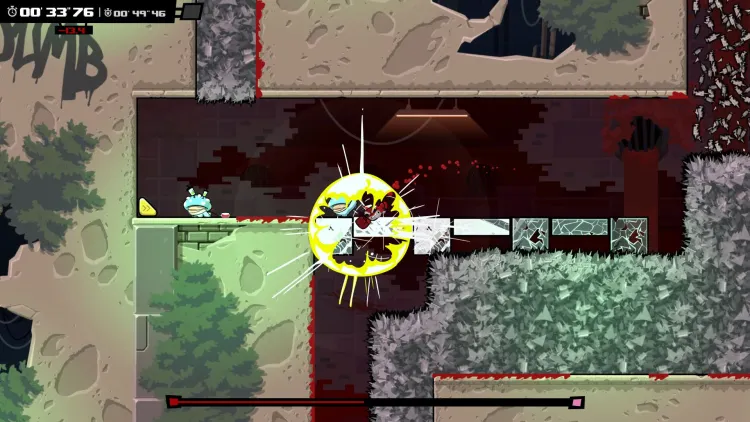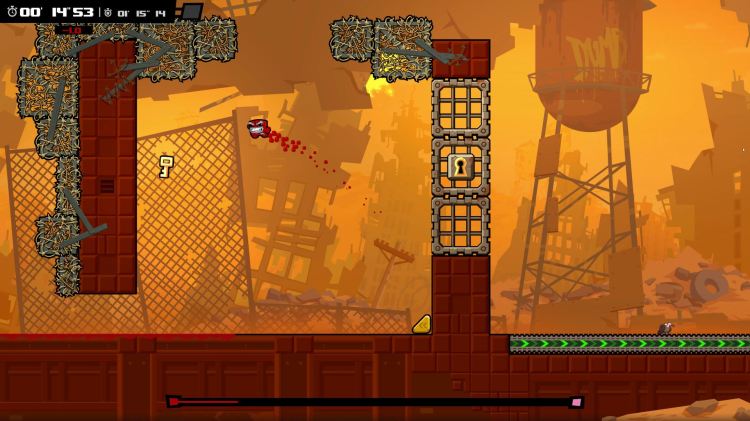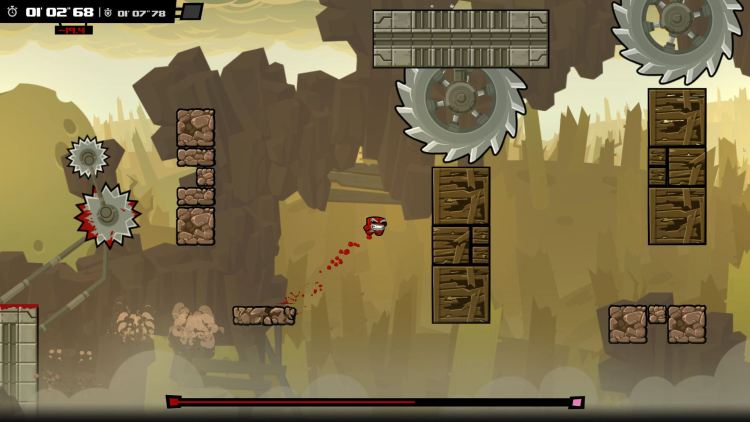Do you hate yourself? If you’re anything like me, you have a strong passion for both gaming and self-masochism. For this reason, the original Super Meat Boy was my self-punishing title of choice when I just wanted to turn off my brain and turn up the frustration level. Now that a new installment is finally assaulting our PCs (not to mention free time), it remains to be seen if the franchise has enough legs to become an honest-to-goodness “brand.” Now, let’s just hope that they didn’t lose their way during the Super Meat Boy Forever development process.
Both the art style and difficulty of Super Meat Boy Forever harken back to the era of 8-bit glory. The only difference this time around is the insane framerates that would’ve blown an NES-adopter’s mind. The gameplay itself, however, feels like a by-product of a failed experiment while porting one of the countless incarnations of Super Meat Boy, to mobile. While I have no proof to truly back up this assessment, it’s worth noting that the newly minted infinite-runner structure was once a staple in numerous early iOS games.
Process of elimination
Following the same trend of streamlining the structure, the controls have also fallen victim to the feature pruning. Once again calling back to the mobile-boom era, everything in Forever can be accomplished using only two action buttons: Slide and Jump. For this reason alone, I was also finally able to play the game on keyboard, using the down arrow and space bar, respectively. Considering the original was designed with a console controller in mind, this drastically paired-back approach was a huge departure from what I was expecting, and a rather immense disappointment, to boot.
As another unwanted side effect of the new infinite-runner redesign, Meat Boy will actually continue moving in whatever direction it’s currently moving until a wall or obstacle is encountered. This means your days of traversing upwards by climbing a single wall have officially come to an end. Any upwards movement can only happen when jumping from back and forth between parallel walls. I believe I can sum my thoughts on this in a single word: YUCK.
One selling point of Super Meat Boy Forever is that the game’s stages are procedurally generated. Yet, it seems like most environments have certain set-pieces that will appear every time through a level, while other portions of a stage’s layout are generated a bit more randomly. The problem was, this hybridized approach to creating a level’s geometry — where only part of each layout was hand-curated — led to an extremely uneven experience when it came to gameplay, challenge, and polish. Additionally, this led to large portions of each map feeling like filler, instead of the pure, concentrated challenge that has been previously enjoyed.
Staying alive
Luckily, the one aspect of the design that made a triumphant return was the damn-near instant respawning, upon your imminent demise. This was both good and bad in certain respects. For one, restarts would happen so quickly that if you weren’t paying attention, the next attempt would start without you. That said, the quick respawning would also help somewhat take the sting out of any death. The problem was, if you were actually trying to analyze what went wrong in the previous run, you’d only have a matter of a couple of seconds before you were forced right back into the retry gauntlet. Thankfully, the checkpoints were fairly generous throughout, because if I had to start at the beginning of each stage every time I died, I would’ve noped the hell out before ever playing a second of the sequel.
I’m pretty sure that the boss battles at the end of each world will likely be a point of contention with the dedicated fans of the franchise. Personally, I didn’t mind the challenges, as they all seemed fairly straightforward. Protip: Attack the “glowy bits.” Some may take issue with this lack of direction, however, since it felt like there was only a single “right way” to defeat each challenger. Once again, the hellish trial-and-error loop was prominently on display, where you only had split seconds to react before the chaos started anew. Plan your attack. Execute that plan. Mess up. Wash. Rinse. Pull out hair. Repeat.
The one area where Super Meat Boy Forever has upped its game is the animated segments that punctuate gameplay. The new emphasis on narrative comes as Meat Boy and Bandage Girl head out on the hunt for Dr. Fetus, who has kidnapped their child, Nugget. The story of what happens next is equal parts odd and endearing. It certainly isn’t going to be up for a Pulitzer, but charming presentation and insane characters help to ensure that the action isn’t being taken too seriously. I mean, how serious can it be when you’re a bloody side of uncooked beef, fighting against a fetus in a jar, who also just so happens to have a doctorate?
In addition to the random regeneration of stages adding to the replayability, there are also countless additional skins to unlock though replaying earlier completed stages. My personal favorite skin was the elderly version of Meat Boy, who my daughter affectionately christened, “Super Meat Grandpa.” Though the core completion of the mainline narrative will likely take less than six hours to complete, it will forever live on through attempting to perfectly polish-off each stage.
As much as Super Meat Boy Forever does feel like a definitive change in direction for the series, this may be one of the rare cases where things are progressing in the wrong direction. Changing the core structure of the action will alienate some, while also lowering the initial barrier to entry. It remains to be seen if they can attract as many gamers as it will spurn, but I know that I’d think long and hard before purchasing this title for full price. Reader, beware.











Published: Dec 31, 2020 02:00 pm